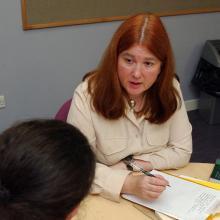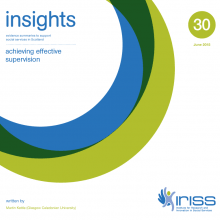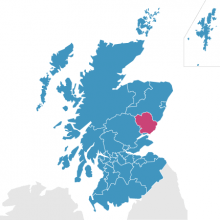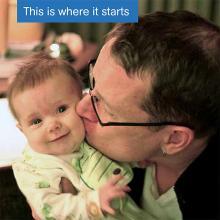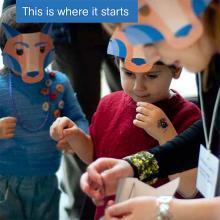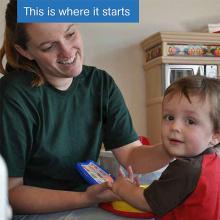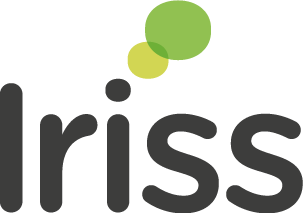Summary
This Outline explores distributed approaches to leadership in the context of childcare and early years settings. It provides some background to Scottish policy priorities and principles of leadership and distributed approaches. It provides a brief overview of potential benefits to distributed leadership approaches for different stakeholders, contextualising the increasing interest in the approach within the childcare and early years sector. It identifies the main bodies influencing the distributed leadership approach in early years and childcare provision in Scotland, outlining their frameworks for leadership at all levels, including the themes and identifiers they use. Examples from practice are provided, illustrating what the leadership themes look like at all levels within an early years and childcare setting. Some training and development resources are identified, many of which are free to access. Some recommendations for further reading around the background and theoretical foundations of distributed leadership are provided.
Introduction
This Outline seeks to address the following question relating to approaches to self directed support: How is leadership relevant to people working at different levels in childcare organisations?
It explores examples of frameworks of leadership at all levels, and identifies examples of leadership at all levels specifically within a childcare context. The purpose of this enquiry was to feed into the development of induction and professional development resources for an early learning and childcare organisation in Scotland, to help employees within the organisation to develop an understanding of how leadership is relevant and applicable to their roles and to participate in service development and provision. Final resources may be shared in the future by the organisation to support workforce development across the sector.
The information need for this enquiry was understood as being within the area of distributed leadership/leadership at all levels/situational approaches to leadership within the fields of education/early years/childcare.
The aim of this Outline is to provide information about what leadership qualities may be relevant to early years and childcare practitioners, identify examples of what these may look like in practice, and highlight training and development resources that may support practitioners. This information and evidence is intended to be restructured by the original enquirer within their own conceptual framework that best suits their own contextual needs.
About the evidence presented below
Although we identified some evidence around distributed leadership in relevant fields, leadership research in early childhood education and care "is a relatively new undertaking" (Hujala et al. 2016) and there is therefore currently not a large body of evidence in this area. Empirical research on distributed leadership in general is "relatively young and narrow in scope" (Heike et al. 2012) and there is therefore a gap in understanding about the effectiveness of the approach within education.
The body of evidence around distributed leadership tends to focus on one of two aspects - conceptualisation and application (Tian et al. 2015). This Outline focuses most heavily on examples of the application of distributed leadership in relevant contexts, to meet the specific information need of the enquirer. However, there is currently a shortage of case studies and other forms of knowledge sharing around distributed leadership in childcare and early years settings, which highlights a need for more activity in this area to support the sharing of good practice.
Accessing resources
We have provided links to the materials referenced in the summary. Some of these materials are published in academic journals and are only available with a subscription through the The Knowledge Network with a NHSScotland OpenAthens username. The Knowledge Network offers accounts to everyone who helps provide health and social care in Scotland in conjunction with the NHS and Scottish Local Authorities, including many in the third and independent sectors. You can register here.
Background
Distributed leadership is "a deliberate process of sharing leadership behaviour, so that team members other than the head or manager take an active lead" (Lindon and Lindon 2012, p.119). Leadership is defined as any "activities tied to the core work of the organization that are designed by organizational members to influence the motivation, knowledge, affect, or practices of other organizational members" (Spillane 2006, p.11) In this approach, leadership is done by anyone engaging in these activities, rather than being defined by role or position.
There is some overlap between the theoretical approach to analysing organisational structures of distributed leadership and practice-led approaches to distributed leadership. Harris and Spillane's 2008 paper provides useful background to the debate in this area.
Scottish context
The Scottish Government's 2014 Building the Ambition (PDF) report sets out national ambitions for leadership in the early years context, stating: "Those in leadership roles in early years establishments need to create a culture which values staff and supports practitioners in improving their skills and Knowledge" (p.49).
The principles of distributed leadership are being applied within parts of the social services sector in Scotland. The Changing Lives: report of the 21st century social work review (PDF) (Scottish Executive 2006) stressed the need for clear leadership and effective management at all levels within the workforce (Iriss 2012). It emphasises:
Leaders aren't all at the top. People at all levels should be given opportunities to lead. Leadership is about doing the right thing. A good leader sticks to their values and isn't knocked off course...Leaders need not necessarily be managers but all managers should be good leaders. (Scottish Executive 2006)
In 2016 Education Scotland published How good is our early learning and childcare? (PDF) which provides national guidance against which practitioners and others can work together to reflect and evaluate their collective impact on improving outcomes for children in their local community. A central aspect of this is leadership.
Additionally, in 2016, the Scottish Social Services Council (SSSC) commissioned research to identify what good leadership looks like in Scotland's social services (George et al. 2016). The report the explores the risks that can undermine effective leadership and the factors that can enable it.
Principles of leadership
What leadership looks like at different levels within an organisation can be extremely varied, but is based on overarching principles and capabilities. The Changing Lives Service User and Carer Panel (Scottish Executive 2006) identified the qualities of effective leadership as being:
- Dedication - this is not just a job but an important job that can make a real difference, positive or negative, to people's lives
- Values - of fairness, equity and inclusion, providing person-centred services and never forgetting why they are there
- Integrity - the ability to keep to their values even under challenge
- Charisma - the ability to motivate others to treat people as they would like to be treated themselves
- Bravery - being prepared to challenge bad practice wherever it may be
- Motivation - the ability to encourage others to do the right thing and not just accept the inadequate
- Credibility - with a firm base of knowledge and experience
HM Inspectorate for Education (2007) provide examples of what distributed leadership looks like in education (PDF):
- Sector managers in colleges, working in partnerships with local enterprise
- Companies to develop skills courses for local workers;
- College senior managers leading college consortia and tracking learners' progress from HNC awards to degree-level provision;
- CLD staff leading multi-agency partnerships as part of community planning and regeneration;
- Youth workers heading up specific projects as part of youth work team;
- Nursery teachers leading Assessment is for Learning (AifL) 13 projects for the early years
- Secondary language specialists leading modern languages in primary schools
- Chartered teachers working as tutors to newly qualified teachers
- Primary principal teachers working across primary and secondary sectors and developing shared approaches to learning and teaching
Impact of distributed leadership on children and families, staff and organisations
In the context of early years and childcare settings, distributed leadership may be applied to all levels of staff, including Support Workers, Child Development Officers, Learning Centre Development Officers, Managers, Heads of Early Years and others working within the organisation. Leadership in early years settings, schools and children's centres has been recognised as significant in raising standards and increasing the quality of educational, health and social outcomes for children (Siraj-Blatchford and Hallet 2014). From an early education perspective, the concept of a traditional leader functioning within a hierarchical system and working in solidarity is simply not thought to be effective as a means of pedagogical leadership (Heikka and Waniganayake 2011 in Beaudin 2017).
Benefits for children
In an educational context, studies suggest that student outcomes have been improved as a result of the positive effect of distributed leadership on staff motivation and performance (Leithwood et al. in Hughes et al. 2014, p.12). OECD (2015, p.70) identify leadership skills as an important skill for facilitating high quality services and outcomes for children.
In terms of specific aspects of leadership, Learning and Teaching Scotland (2010) argue that the leadership demonstrated through self-evaluation enables practitioners to make links between practice and what is known about child development and learning. Reflection and self-evaluation help improve practice and enhance the quality of childcare provision, as well as supporting the creation of a positive ethos that helps ensure planning is responsive and child-focused.
Benefits for staff
Setting staff identified strong leadership as a factor in staff retention. Managers with passion and energy were inspirational and good managers were viewed as those that were able to recognise the strengths of their staff and utilise these effectively.
A shared purpose and vision was also important for staff retention. Staff described having a common purpose in providing high quality early education for the children in their care and a clear understanding of how they were aiming to achieve this:
So we all know what we're doing. We all know what our roles are and [the setting manager is] very good at feeding back other things from what's happening in the rest of the school.. So I think that helps with good provision...Because we all know where we're going. We're all sort of like singing from the same song book as it were. (Callanan 2017)
Benefits for organisations
Members throughout the organisation are able to take responsibility for some areas developing best practice (Lindon and Lindon 2012, p.119).
Staff bring their own qualities, values and principles to the early years setting and it is important to recognise the impact that these attributes have on children. Effective leaders promote distributed leadership at all levels, where staff and children are empowered and able to take lead roles within and beyond the setting where appropriate. Establishing a clear vision, identifying shared aims, and capitalising on individual strengths, impact positively on young children, staff and parents. Where leadership is distributed, all staff can be leaders, supporting, promoting and improving evidence-based practice. (Learning and Teaching Scotland 2010)
A three-year study of distributed leadership in a school district in Canada with over 180 schools, 8,800 teachers and 400 school administrators found that more coordinated forms of leadership distribution make more productive contributions to organizational outcomes (Mascall 2008).
Benefits for wider sector
Distributed leadership has been identified as a way of creating the conditions for systems leadership across the childcare and early years sector, which is a way of improving practice on a large scale. Hughes et al. (2014, p.2) state:
Before leaders can step outside their organisation to support other organisations or wider sector objectives, they must be confident that their own projects will not suffer through their absence. Creating capacity within an organisation can be necessary, with sufficient staff to cover the core leadership functions of the organisation itself, as well as systems leadership functions.
Leadership capabilities
We identified three key bodies developing conceptual frameworks around distributed leadership in Scotland relevant to the early years and childcare context: Scottish College for Educational Leadership, Education Scotland and the Scottish Social Services Council.
Scottish College for Educational Leadership (SCEL)
Examples from the Scottish College for Educational Leadership around what leadership at different levels in the schools context looks like may provide an applicable starting point for the early years and childcare context. This addresses the tensions around whether leadership is for all or for people in management positions (for more context see McCartney and Forbes 2015):
Teachers
Teachers demonstrate leadership through their passion for caring for all children and young people. Through informed and innovative practice, close scrutiny of pupils' learning needs and high expectations they play a fundamental role in improving outcomes for children and young people. Teachers develop leadership through effective communication and collaboration with colleagues. Teachers as leaders demonstrate integrity, have a positive impact on their school community and model career-long professional learning.
Middle leadership
Middle leaders are key drivers in ensuring positive outcomes for all learners. Through working collaboratively with school leaders, members of their teams and partners, they devise and contribute to the school's vision and values, ensuring that the strategic direction of the school is communicated effectively with all stakeholders.
School leadership
As lead learners, school leaders ensure that a strong and consistent focus is placed on learning and teaching in their schools. They have, and outline, clear and high expectations regarding the standard of learning and teaching which they expect to see throughout their school and drive improvements in attainment and achievement. They are adept in motivating teachers to meet these standards and work closely with middle leaders to provide effective on-going support and challenge for teachers to ensure excellence in learning and teaching.
School leaders drive and promote a culture of self-evaluation, using evidence-based practice to bring about improvement. It's important that, working with senior colleagues, school leaders have effective systems in place to evaluate the impact of learning and teaching on learner progress and engage in constructive dialogue with teachers to inform on-going school improvement. School leaders ensure that curricula best meet the needs of all children and young people, offering opportunities for the development of skills for learning, work and life and using a range of inspiring pedagogy and well-judged innovation.
System Leadership
System leaders lead in their own organisations and are able to share their expertise and work jointly with leaders from other areas of the system in order to drive improvement and successful outcomes.
Education Scotland
In 2016 Education Scotland published How good is our early learning and childcare? (PDF) which provides national guidance against which practitioners and others can work together to reflect and evaluate their collective impact on improving outcomes for children in their local community. A central aspect of this is leadership. The quality indicators and themes identified were:
Self-evaluation for self-improvement
- Collaborative approaches to self-evaluation
- Evidence- based improvement
- Ensuring impact of success for children and families
Leadership of learning
- Professional engagement and collegiate working
- Impact of career-long professional learning
- Children leading learning
Leadership of change
- Developing a shared vision, values and aims relevant to the ELC setting and its community
- Strategic planning for continuous improvement
- Implementing improvement and change
Leadership and management of practitioners
- Governance framework
- Building and sustaining a professional team
- Practitioner wellbeing and pastoral support
Management of resources to promote equity
- Management of finance for learning
- Management of resources and environment for learning
The report provides features of highly effective practice for each of these themes (pp.11-21), which may be built into the induction and professional development resources for organisations.
Scottish Social Services Council (SSSC)
The 2016 SSSC Enabling Leadership report (George et al. 2016) outlines the knowledge, skills and attributes identified as supporting the development of leadership. Specific examples of what good leaders do are provided (pp.17-20) including sustaining motivation, showing passion, being generous in the recognition of others, building trust, speaking truth to power, making difficult decisions, being accountable, managing relationships, using mistakes made as learning experiences, and actively reflecting on performance.
The SSSC has produced a set of Leadership Capabilities Indicators for Frontline Workers which may have cross-sectoral applicability. Each capability is described across three stages of progression: emerging, established and accomplished. The leadership capabilities indicators are: vision - seeing what is possible for individuals, families and communities now and in the future; self-leadership - recognising, exercising and improving own leadership; creativity and innovation; empowering people - enabling others to develop and use their leadership capacity; collaborating and influencing; and motivating and inspiring others.
Demonstrating leadership
Using the indicators from the framework from SSSC's Enabling Leadership (2016) and Education Scotland's HGIOELC (PDF) (2016)as the main themes, below we outline examples of ways these indicators can be demonstrated at the different levels. We have identified examples relevant to how these may be demonstrated in a childcare context.
Vision
Having vision is described in the National College for School Leadership (Sharp et al. 2012) report on highly effective leadership as a set of knowledge, skills and attributes "related to the core purpose of children's centres and communicated to all who come into contact with the centre". Specific examples of these are provided:
Knowledge
- Knows about policy imperatives
- Has safeguarding knowledge and skills
- Knows about child development
- Understands what families need to be successful
Skills
- Communicates clearly and directly
- Instils this child-centred vision in others
- Inspires support for child-centred vision from all staff
- Leads and accepts challenge
Attributes
- Strong commitment to moral purpose
- Principled, innovative and strategic
- Positive, can-do attitude
- Focused and self-assured
Examples of this within the research literature around leadership includes the idea of a "shared vision guiding action across an organisation":
It's often the very top where the CEO will say, 'Well this is what our goal is for this year.' Then the director of each department will say, 'Well, what is it our department has to do to contribute to that goal?' ...So it trickled down from level to level and every single person within the organisation knows exactly how their individual contribution fits into the very top objective. (Hughes et al. 2014, p.15)
The SSSC has identified several indicators relating to demonstrating vision at different levels:
| Theme of indicator | Emerging | Established | Accomplished |
|---|---|---|---|
| Seeing how best to make a difference | I can see how the lives of the people who use my service, their families and carers could be better, how I can help them to achieve this in my own role and as part of a team. | I work in partnership with the people who use my service, their families and carers, my team, managers and other colleagues to develop clear goals and plans to achieve better outcomes for the people who use the service and I can identify where I have made a difference. | I can clearly articulate my vision for individuals, families and the community to a broad range of people within and out with my own sphere of influence. |
| Communicating and promoting ownership of the vision | I can support the people who use my service, their families and carers to see how their lives could be improved. I can explain this, my role and what I think the team's role could be to my colleagues and take them with me. | I can communicate my team's vision and the vision of the service as a whole to people who use the service, their families and carers and to colleagues in my own service and those I work with in other services. | I actively seek to influence the vision of my team, service and organisation and I promote ownership of this vision within and out with the organisation |
| Promoting social service values | I remain focused on the needs of people who use services when faced with conflicting priorities | I have a public service ethos which puts outcomes for individuals, families and the community first. | I actively promote core social service values with individuals, families, communities and colleagues in my own and in partner organisations and I challenge behaviours which undermine these values |
| Seeing the bigger picture | I take responsibility for keeping up to date with changes in the organisation and the wider context in which I am working and I understand the rationale for these changes. | I understand the challenges and opportunities affecting individuals, families, the community and the organisation and I can see these from a range of perspectives including those of people who use services, carers, colleagues and managers. | I share my insight appropriately with others within and out with the organisation to challenge views and bring about continuous improvement. |
Table adapted from leadership capabilities indicators for frontline workers (PDF) (SSSC no date)
Self-leadership
This overlaps with Education Scotland's theme 'self-evaluation for self-improvement'. Learning and Teaching Scotland (2010) emphasise that continuous reflection is important for staff, to ensure that they consider what they are doing, why they are doing it, and ensure that it is evidence informed and up-to-date. They provide examples of what forms this can take:
- Discussion forums
- Visiting other early years settings
- Keeping up to date with relevant research
- Attending online, virtual or other conference events
- Undertaking a course of study at university, college or in the workplace.
- Online forums
- Collaborating through Glow, Scotland's national intranet for education
NCSL (Sharp et al. 2012) identify actively seeking out opportunities to further learning, including learning from others, as core to self-leadership. Specific examples of self-leadership capacities are provided:
Knowledge
- Understands child development and adult learning
- Understands the principles of professional development
- Understands the principles of collaborative learning
Skills
- Is able to adopt reflective, critical practice
- Is able to plan own development and learning
- Shares and develops practice with others
- Learns from others
Attributes
- Has self-awareness
- Is committed to continuous learning and development
- Is open to mutual challenge and support
- Is willing to learn from others
- Listens to feedback from others
- Is willing to try new things
The SSSC has identified several indicators relating to demonstrating self-leadership at different levels:
| Theme of indicator | Emerging | Established | Accomplished |
|---|---|---|---|
| Demonstrating and adapting leadership | I can see how I demonstrate leadership in my current role and I believe I can develop this further. | My leadership style to take account of the people I am working with and the situation I am working in. | I successfully adapt my leadership style, skills and abilities to work in partnership with others within and outwith my own service to achieve the best outcomes for individuals, families and the community. |
| Improving own leadership | I reflect on my leadership approach and seek advice and support to improve. | I actively seek feedback from others, including people who use services and their carers, to improve my leadership. | I use research and evidence to inform and continually improve my approach to leadership. |
| Taking intelligent risks | I can see where I and the people I work with could take intelligent risks, based on sound risk assessment and risk management, to support the people who use my service, their families and carers to improve their lives. | I am prepared to take calculated risks, based on sound risk assessment and risk management, within my own area of authority and I can see the possible consequences of these. | I use research and evidence to assess, manage and evaluate the risks I take to achieve better outcomes for individuals, families and the community while remaining accountable for the service delivered. |
| Demonstrating and promoting resilience | I sustain efforts to overcome obstacles and feelings of frustration and am able to maintain and encourage others to maintain a positive view. | I actively contribute to the development of strategies which build resilience and sustainability in the workplace. | I am persistent and creative in my approach to achieving successful outcomes at individual and organisational levels. |
| Challenging discrimination and oppression | I acknowledge and challenge forms of discrimination and oppression. | I am able to work effectively with others to deal with issues of discrimination and oppression. | I use evidence and research to inform my innovative approach to antidiscriminatory and anti-oppressive practice. |
Table adapted from leadership capabilities indicators for frontline workers (PDF) (SSSC no date)
The Education Scotland National Improvement Hub has a set of resources around self-evaluation and improvement.
Creativity and innovation
The SSSC has identified several indicators relating to demonstrating creativity at different levels:
| Theme | Emerging | Established | Accomplished |
|---|---|---|---|
| Seeing opportunities to do things differently | I can see how I, my team and the service could do things differently and in a way which would support people using the service, their families and carers to have better lives. | I can bring fresh perspectives and think creatively about the options available in any situation. | I see the potential for improvement in a range of situations and am ready to act on opportunities which present themselves and to create solutions. |
| Promoting creativity creative and innovation | I am able to use my initiative and act on opportunities to improve outcomes for people who use services and their carers. | I encourage others to demonstrate initiative through collaborative working and the sharing of good practice. | I use research and evidence to find innovative approaches which lead to improved outcomes for people who use services and their carers. |
| Supporting and managing change | I consistently make identifiable contributions to and/or lead change and improvement in my own team and support colleagues to embrace change. | I consistently make identifiable contributions to change and improvement in the wider service/ organisation and constructively and appropriately challenge people, assumptions and organisational constraints which impede new and creative ways of working. | I can manage the complexity and uncertainty of major change and work with others within and outwith the organisation to embrace opportunities and find innovative ways to overcome challenges. |
Table adapted from leadership capabilities indicators for frontline workers (PDF) (SSSC no date)
Education Scotland has produced a video about the need for staff and children to be able to think creatively. The video is for practitioners who want explore and understand educational thinking around Creativity.
Empowering people
The SSSC Continuous Learning Framework conceptualises empowering people as "working in partnership with individuals, families and communities to enable them to lead their own lives".
One aspect of empowerment is staff feeling empowered within organisations. Hughes et al. (2014, p.33) identify collaboration as requiring working through tension:
Leaders need to create enough trust that encourages people to speak truth to power. Essentially people need to know that you're not going to get fired or pressured for speaking out.
The SSSC has identified several indicators relating to demonstrating empowering people at different levels:
| Theme | Emerging | Established | Accomplished |
|---|---|---|---|
| Enabling leadership at all levels | I acknowledge the capacity for leadership in colleagues, people who use services, their families and carers | I recognise, support and nurture the leadership of people who use services, their families and carers and colleagues and help them to recognise their own leadership. | I actively share leadership, learning and ideas among people who use services, their families and carers, across the organisation, with partner organisations and with the wider community. |
| Supporting the creation of a knowledge and management culture | I share information and knowledge consistently to model the behaviours needed to create a knowledge management culture. | I actively seek networks, communities and other sources of knowledge and encourage others to do so to champion the creation of a knowledge management culture. | I contribute to the strategy and action plan for creating a knowledge management culture within the organisation which values the use of knowledge and seeks to embed it at the heart of practice. |
| Promoting professional autonomy | I am able to explain and provide evidence for my practice and expect to have my thinking challenged appropriately. | I am prepared to make and be accountable for decisions that are appropriate to my role. | I actively encourage and support colleagues to take a leadership role, be innovative and take appropriate decisions. |
| Involving people in development and improvement | I actively promote the empowerment of people who use services and their carers and I work in partnership with them and others to achieve this. | I actively support colleagues and managers to involve people who use services and their carers in more meaningful ways | I demonstrate creative and innovative approaches to involving people who use services and their carers including those who are members of minority and disadvantaged groups. |
Table adapted from leadership capabilities indicators for frontline workers (PDF) (SSSC no date)
Collaborating and influencing
Halttunen (2016) describes collaborative responsibility as a way staff in a day care unit took leadership. They "tried to sort things out by themselves before contacting the director" (p.10) and ensured that the centre director was informed about the decisions that had been independently made by the staff. For example:
During a staff meeting the representative from a remote unit asked for help to arrange their team meetings. It seemed to be very easy to make the arrangement for the next meeting but immediately after the arrangement had been made, some of the staff members started to quietly discuss how they could make a permanent arrangement. The director as a chair of the meeting was not involved in this part of the discussion.
The SSSC has identified several indicators relating to demonstrating collaboration and influencing at different levels:
| Theme | Emerging | Established | Accomplished |
|---|---|---|---|
| Promoting partnership working | I take active steps to build relationships, develop networks and promote partnership working. | I actively seek opportunities to work in partnership with others within and beyond the organisation. | I provide an ongoing and dynamic link between the workplace, the organisation, other agencies and wider networks. |
| Influencing people | I build trusting relationships with people who use my service, their families and carers and with my team and manger and I can present information and evidence in a way that everyone can understand so that we can work together to improve the lives of the people using the service. | I build trusting relationships within and outwith the organisation and use these and evidence, information and research to influence the thinking and behaviour of others towards shared purpose and goals. | I am able to hold on to and balance different perspectives and take others with me towards shared purpose, goals and outcomes. |
| Understanding and valuing the perspectives of others | I can recognise and understand differences in views and the constraints which others are working under. | I seek to understand and empathise with the diverse views of others and can often find creative solutions that are acceptable to all concerned. | I champion diversity and inclusion and can constructively challenge my own and others' stereotypes and assumptions. |
Table adapted from leadership capabilities indicators for frontline workers (PDF) (SSSC no date)
Motivating and inspiring others
NCSL (Sharp et al. 2012) identify collaboration and continuous learning as central to motivating others. Specific examples of these capacities are provided:
Knowledge
- Understands the impact of staff motivation on morale and retention
- Understands that different people have different skills and strengths
- Understands distributed leadership and its practical application
Skills
- Demonstrates trust in staff
- Delegates responsibilities to the team, while keeping a grip on performance
- Encourages autonomy and creativity
- Works collaboratively through teamwork
- Develops leadership skills in others
- Addresses underperformance
Attributes
- Values staff and recognises their capabilities and capacities
- Shows belief in staff
- Is committed to learning and development of others
- Is able to create and sustain commitment across the whole setting
- Grants staff freedom, but with effective supervision and support
The SSSC has identified several indicators relating to demonstrating motivating others at different levels:
| Theme | Emerging | Established | Accomplished |
|---|---|---|---|
| Inspiring people by personal example | I have high expectations of myself based on a best practice approach and I support and encourage others to do so too. | I model positive leadership behaviours that inspire enthusiasm and confidence in others and motivate them to achieve identified goals. | I am recognised for my skilled leadership and the way I inspire others to continually improve. |
| Recognising and valuing the contribution of others | I actively share and promote good practice within my own team, service/organisation and with colleagues in other services I work in partnership with. | I encourage and motivate others to make best use of their individual and collective abilities | I recognise, value and champion the contribution of people who use services and their carers, colleagues in my own and partner organisations and managers to improving outcomes for the people who use my service. |
| Supporting the creation of a learning and performance culture | I model critically reflective practice and actively promote the learning and development of others through a range of formal and informal approaches. | I use a range of evidence to evaluate my own performance and to contribute to the evaluation of the performance of the team and the service to continuously improve outcomes for individuals, families and the community. | I actively contribute to an organisational culture which promotes learning by facilitating the sharing of ideas within and outwith the organisation and with people who use services and their carers. |
Table adapted from leadership capabilities indicators for frontline workers (PDF) (SSSC no date)
The How good is our early learning and childcare? (PDF) (2016) Leadership and management quality indicators not covered by the SSSC categories are:
Leadership of learning
Pedagogy is "about the interactions and experiences which support the curriculum and the process of how young children learn" (Scottish Government 2014). Pedagogical leadership is conceptualised by Education Scotland (2017) as including:
- Monitoring quality of provision
- Passion
- Delegation
- Professional values
- Excellent knowledge of how young children and infants develop and learn
- Reviewing staff forward plans
- Sharing good practice
- Management of the setting
- Control of budgets
Skills, knowledge and attributes identified by Education Scotland (2017) relating to good leadership of learning include:
- Empowering staff
- Shared vision
- Relationships at all levels
- Creativity and innovation
- Linking research and practice
- Effective communication and consultation
- High quality teaching and learning
- Self-evaluation and monitoring
- Positive role models
In terms of the relationship between evidence and practice, they suggest pedagogical leaders:
- Identify new developments in pedagogy
- Set the pedagogical agenda by maintaining an awareness of the issues in pedagogy
- Achieve and maintain credibility in both the practitioner and research worlds
- Engage in open discussion and exchanges with their colleagues by presenting their ideas in public forums and documents
- Are able to communicate the views and findings of practitioners and researchers to others involved in the ELC field
- Help researchers and practitioners understand each others' perspectives and their contributions to the field of ELC
Actions of a pedagogical leader include:
- Enhance discussions of pedagogy, increasing expertise.
- Creates a strong vision
- Sets a good example by striving to provide high quality early learning and childcare
- Helps support and develop well thought out innovation
- Enhances the capacity and commitment of others to change
- Creates a strong culture of improvement
An example of pedagogical leadership is provided in the NCTL Report Freedom to Lead (PDF) (Matthews et al. 2014), which includes a section on examples of leadership at all levels (pp.29-35). A change in culture and practice within schools through observation and monitoring alongside building up the capacity of staff was identified as supporting teachers to take initiative and innovate. This practice is identified as equipping subject leaders to take responsibility for their subjects.
HMIE (2007) provide examples of what leadership of learning at all levels looks like:
Staff at different levels can and do make an impact on the learning, motivation and achievement of children and young people. Leadership for learning is provided by a range of staff, including, for example:
- Pre-school staff who establish a love of learning and engage children through imaginative and purposeful play
- Teachers who build the confidence of learners so that they attain the skills to become leaders of their own learning
- College and community staff who work with young people who have had a poor experience of education and who support their entry back into a world of learning that enriches their lives
- Care and education staff working together effectively in residential schools and secure care accommodation services to meet the social, emotional, health, behavioural and learning needs of vulnerable pupils
Leadership of change
Leadership of change relates to developing a shared vision, values and aims for the organisation, strategic planning and implementing change.
The NCTL's Freedom to Lead (PDF) report (Matthews et al. 2014) suggests that identifying the right staff to lead change is a key strategy for sustaining excellence:
A core of three or four staff were identified to act as beacons of good practice and leaders of teams. The headteacher was looking for staff "who will not be tired by change, who will be engaged and interested in learning; I want people who are intellectually hungry. We want staff here who will love it and share the challenge." (p.44)
Education Scotland (2016) identify leadership of change as involving developing a shared vision, values and aims relevant to the ELC setting and its community, strategic planning for continuous improvement and implementing improvement and change. They say:
This indicator focuses on working together at all levels to develop a shared vision for change and improvement which reflects the context of the setting within in its community. Planning for continuous improvement change should be evidence-based and clearly linked to strong self-evaluation. Senior leaders should ensure that the pace of change is well judged and appropriate to have a positive impact on outcomes for children.
They provide examples of what this looks like in practice, including several previously outlined in this report, including vision, self-leadership, creativity, collaboration and motivating others.
Leadership and management of practitioners
This category from Education Scotland (PDF) (p.18) focuses on the importance of sound governance within the early learning and childcare setting. It therefore lends itself to traditional leadership models, but does include elements where all practitioners may play a role:
- Through an effective professional review process, based on coaching and mentoring, practitioners reflect on their professional skills and knowledge and identify areas for improvement
- All practitioners willingly engage in a wide range of professional learning activities to improve their practice
- We are proactive at tackling any prejudice-based discrimination
- Our practitioners are empowered and motivated to make decisions and lead on aspects of improvement
- Opportunities to consult, share information and raise concerns are well established and understood by all practitioners
- Lines of accountability are clear
- All practitioners share information effectively, listen to others and respond positively to ideas and issues raised with them
The document provides examples of highly effective practice and prompt questions for managers to support these practices.
Management of resources to promote equity
Education Scotland (2016) identify management of finance for learning and management of resources and environment for learning as leadership behaviours. Although management of finance may not be a distributed responsibility, in many cases people working directly with children are well-placed to demonstrate leadership through the promotion of equity. The Education Scotland resources on Interventions for Equity may be of relevance. Suffolk Council's Guidance for promoting equalities in early years and childcare (PDF) (no date) and East Lothian Council's (no date) Equality and inclusion guide also provide specific examples of what the promotion of equity looks like in practice and what people in different roles can do to make sure equality policies are upheld.
Common Core (Scottish Government 2012)
Siraj and Kingston (2015) provide a clear outline of the Common Core (Scottish Government 2012):
The Common Core describes the essential skills, knowledge, understandings and values that all people working with children and young people and their families, whether paid or unpaid, should have. The Common Core is relevant to all those working with children, young people and families in health, education, social services, justice, community services, cultural and creative industries, the voluntary and private sectors. The Common Core relates to two contexts: relationships with children, young people and families; and relationships between workers. These contexts are to be met through the implementation of four principles: non-discrimination; best interests of the child; right to life, survival and development; and the obligations to consider children's views and a series of essential characteristics.
The Common Core links to other Scottish policy (e.g.GIRFEC) and the United Nations Convention on the Rights of the Child (UNCRC). As such, the following common values are promoted:
- Promote the wellbeing of individual children and young people
- Keep children and young people safe
- Put the child at the centre
- Take a whole child approach
- Build on strengths and promote resilience
- Promote opportunities and value diversity
- Provide additional help that is appropriate, proportionate and timely
- Support informed choice
- Work in partnership with families
- Respect confidentiality and share information
- Promote the same values across all working relationships
- Make the most of bringing together each worker's expertise
- Co-ordinate help
- Build a competent workforce to promote children and young people's wellbeing
- These values may form a useful conceptual framework around which to base leadership at all levels in a childcare context.
Evidence from practice
Denise Baines Childminding Services (no date) The effectiveness of leadership and management of the early years provision (website)
This statement from a practitioner provides some examples of what leadership activities can look like for a childminder.
Education Scotland (2017) Distributed leadership in Shortlees Primary School, East Ayrshire (video)
Shortlees Primary leadership team set up four working parties to explore Literacy, Numeracy, Health and Wellbeing and Assessment is for learning. Each working party was encouraged to explore how educators, learners and parents can be encouraged to, not only take part in, but lead aspects of learning in the school community. A variety of options were explored. One of the most effective was when learners brought their parents into school to show them how they were learning.
Education Scotland (2017) Development of 'A Curriculum for All' in Craigroyston Community High School, Edinburgh (Word doc)
A case study of Craigroyston Community High School's innovative approach to the redesign of their whole curriculum through the broad general education (BGE) and senior phase, aimed at meeting the needs and improving the life chances and employability opportunities of all their learners. Although aimed at people working in secondary education, an impact of the work discussed was that the school provides wide opportunities for teachers to exercise leadership, and distributed leadership is now embedded across the staff as a whole, so this may be of relevance.
Education Scotland (2016) Building the Ambition at Arnprior Nursery, Stirling (video)
This practice exemplar showcases how both children and practitioners are being successful leaders of learning at Arnprior Nursery.
This exemplar includes two video case studies:
- Children leading learning at Arnprior Nursery
- Distributed leadership at Arnprior Nursery
In both examples, nursery staff describe their practice in leading learning.
Education Scotland (2016) Raising aspiration and attainment in literacy, numeracy and health and wellbeing at Canal View Primary School, City of Edinburgh Council (pdf)
This case study shares a description of the approach toward developing transformational change in Canal View Primary School. As a school in the Scottish Attainment Challenge, the adoption of a holistic approach to both targeted and universal interventions resulted in a significant rise in attainment. A strong thread through all innovations is distributed leadership and giving staff ownership of innovations.
Hadfield, M et al. (2010) Longitudinal study of early years professional status: an exploration of progress, leadership and impact. Final report (PDF). CeDARE, University of Wolverhampton for Department for Education (pdf)
This report provides some useful contextual information about distributed leadership in an early years context, including practice leadership that has demonstrated an impact on quality. It is the final report of the study that focused on the two multimedia case studies detailed below.
Table 2 Case study EYPs provides practical examples of the role of the EYP, several of which are distributed in scope. For example:
- Leader of the Nursery room and takes a lead on planning and supervision on a daily basis. Also delivers training to staff in developing adult/child interactions.
- Manager works at a more strategic level while the pre-school teacher and EYP leads practice in the nursery with shared decision making with manager regarding staffing.
- Crèche manager though spends a proportion of her time in the research base overseeing CPD and training alongside EYPb. At other times, EYP has distinct roles and responsibilities including supervision of 2 supervisors and 7 practitioners.
Hadfield, M et al. (2013) Establishing practice leadership at all levels. Centre for Developmental and Applied Research in Education (multimedia case study)
This case study outlines the establishment of practice leadership at all levels in a voluntary early years setting. It includes details of leadership of change, leadership of learning, and leadership and management of practitioners. Professional network analysis conducted before and after the changes made to the organisation highlight that leadership in the form of advice and support has become more evenly distributed among staff.
Hadfield, M et al. (2013) Practice leadership for quality and equality (multimedia case study)
This case study outlines how leadership at all levels is used as an approach to undertake quality assurance and equality policy responsibilities. Videos from practitioners detail the benefits of not being in management roles but engaging in work of this nature.
Irving, L (2011) Leading effective collaborative practice (pdf)
This report is a piece of BA Childhood Practice student work on professional collaboration and parental involvement. The author reflects on her supervisory and leadership experience as a Senior Early Years Officer in a local authority day nursery and how she used leadership capacities to support parental involvement within an educational setting.
SSSC (2017) Lisa France, childminder, talks about demonstrating leadership in her service (video)
In this video a childminder talks about one of the first moments she realised she was demonstrating leadership in her service. She talks about the local childminding group as 'leaders together', supporting each other to provide a professional childminding service for children and their families.
SSSC (2014) Leadership Exchange at the SSSC (audio)
EO Anna Fowlie talks about Leadership Exchange and what it means to the SSSC. The Leadership Exchange programme pairs up staff across sectors with the aim of improving leadership capacity between peers. Learn more here.
McCrea (2015) Leading and managing early childhood settings: inspiring people, places and practices. Port Melbourne: Cambridge University Press (book)
McCrea (2015) identifies four professional roles within the early years context with different actions that characterise them:
Team stakeholder
Sourcing and recruiting new staff to fill vacancies, assigning responsibilities to each member of staff, providing support and mentoring for staff, creating opportunities for staff professional development, creating harmonious working relationships and if conflicts occur, resolving them amicably, organizing and conducting staff meetings, attending to each staff member's needs and providing for occupational health and safety in the ECE
Policy designer
Professional actions necessary to make sure that the policies designed to provide for governance in the ECE setting are legal, fair, just, democratic and transparent, minimize risk to the children and anybody involved with the ECE setting, provide guidelines for all stakeholders of the ECE site, and having protocols that are flexible for the efficiency of the ECE setting (Bryant & Gibbs, 2013).
Pedagogy creator
Every practice in ECE that is intended to give young children an authentic pedagogy. Focus on teaching, learning, assessment and curriculum, but also everyday wellbeing of children. Designing, developing and making available educational resources to help children learn and be children. Contributing to the vision and strategies that facilitate knowledge construction.
Rights advocate
Undertaking workplace maneuvers raising voices to advance the wellbeing of young children, in the ECE setting and beyond.
These roles may be useful in developing a conceptual framework around which to base organisational professional development programmes and resources.
Training and development resources
The following resources may be useful to include in organisational professional development programmes and tools:
Early Years Foundation (2017) Training search (website)
Several search results relate to leadership development and may be applicable to the childcare and early years context.
Education Scotland (2017) Building the Ambition national practice guidance (website, pdf, Word docs, videos)
These materials are intended to help practitioners at all levels engage more deeply with the guidance from Building the Ambition. It includes evidence from research around pedagogy and child development, and practice examplars.
Education Scotland (2017) Pedagogical leadership in early learning and childcare (Powerpoint and Word documents, video)
The aim of this resource is to support leaders and those working within leadership teams to reflect on their understanding of pedagogical leadership as well as their role as a pedagogical leader and how this can be developed further or improved through professional reflection and dialogue. This resource is for those who are leaders or are part of a leadership team within an early learning and childcare setting or who have a responsibility for early learning and childcare provision within a primary school. The examples provided may be actionable at all levels within a childcare and early years context.
Scottish College for Educational Leadership (2017) Teacher leadership programme (online delivery through Glow)
The SCEL Teacher Leadership Programme supports and challenges teachers to become more confident in leading classroom practice in their contexts and develop against the GTCS Standard for Career-Long Professional Learning. More information can be found on the SCEL website.
SSSC (2017) Learning resources for people working in children's services (website)
This page provides information about free resources produced by SSSC, including:
- SSSC Learning Zone
- Open Badges
- Step Into Leadership
- Open Educational Resources
SSSC (2017) Step Into Leadership (website)
This programme produced by the SSSC provides various resources to support professional development and learning at all levels. Their website provides links to resources for supervision, mentoring, coaching, leadership exchanges and action learning. It is connected to the The Continuous Learning Framework (CLF), which sets out what people working in social services need to be able to do their jobs well now and in the future and what their employer needs to do to support them.
There are currently 12 open badges available through the SSSC related to leadership development. Several of these are linked to the SSSC Step Into Leadership Programme. The programme supports leadership development for frontline workers as well as managers:
As a frontline worker, your leadership skills can make a real difference to the service that you deliver, and to the outcomes that the people who use your service achieve. There are many ways in which you might show leadership at the front line. For example:
- Using your initiative to support individuals and families to achieve their goals
- Inspiring colleagues to think differently
- Supporting others to learn and develop
SSSC (2017) Leadership Apps (applications)
The SSSC has developed several apps that may be relevant to leadership development for childcare and early years practitioners. For example: engaging with children, communication and relationships, maintaining your development and health and safety.
SSSC (2017) SSSC Learning Zone (website)
All the resources on this website are free and can contribute towards post Registration Training and Learning (PRTL). Employers are welcomed to use the resources within their workplaces. This is a hub for a wide range of SSSC learning resources that can be searched for by theme (e.g. leadership).
Sylva, K, Sammons, P and Goff, J.C (2011) Leadership development resources for children's centre staff: Making the training pack work for you (Open Access)
The authors write:
Self-evaluation has rapidly shifted to the fore in recent years. This pack provides a set of resources that will encourage learning and development within your organisation through institutional self-evaluation. The resources aim to ease the difficult task of self-evaluation, which normally relies on a detailed understanding of the quality of provision, the centre leadership structure, changes in family outcomes, numbers and descriptions of families who attend and those targeted in the catchment area who do not currently attend, along with feedback from parents.
Background reading around distributed leadership
When seeking to implement distributed leadership within an organisation it may be beneficial to gain an understanding of the different approaches to distribution that can be taken. The following papers provide context to the origins of the approach and consider the implications of different forms of implementation.
Bolden, R (2011) Distributed leadership in organizations: a review of theory and research. International Journal of Management Reviews, 13, pp.251-269 (Open Access)
This paper provides an interesting background to the origins of distributed leadership and clearly outlines different approaches to distributed leadership that can be taken through a series of frameworks derived from research in an educational context (p.258). These include:
- Gronn's (2002) model of spontaneous collaboration, intuitive working relations and institutionalized practice
- Leithwood et al.'s (2006) concepts of planful alignment, spontaneous alignment, spontaneous misalignment and anarchic misalignment
- MacBeath et al.'s (2004) different models of distribution - formal, pragmatic, strategic, incremental, opportunistic and cultural
- Spillane's (2006) model of collaborated, collective and co-ordinated distribution
Significantly, the author emphasises the need for a critical approach to distributed leadership to understand the impact of discussion and application of the approach in engaging/disengaging staff, and challenging or reinforcing traditional forms of organisation.
Endres, S and Weibler, J (2017) Towards a three-component model of relational social constructionist leadership: a systematic review and critical interpretive synthesis. International Journal of Management Reviews, 19, pp.214-236 (Available with NHSScotland OpenAthens username)
This review of research around relational social constructionist approaches to leadership takes a critical approach and provides useful background to the theories underpinning certain approaches to distributed leadership. It provides a model of distributed leadership that the authors argue may help practitioners avoid "developing overly idealistic or implicit ideological leadership approaches".
Heikka, J and Waniganayake, M (2011) Pedagogical leadership from a distributed perspective within the context of early childhood education. International Journal of Leadership in Education: Theory and Practice, 14(4), pp.499-512 (Available through NHSScotland document delivery service)
This paper provides a background to the concept of pedagogical leadership in childhood education and the foundational concepts of leadership and pedagogy.
Kivunja, C (2015) Leadership in early childhood education contexts: looks, roles, and functions. Creative Education, 6, pp.1710-1717 (Open Access)
This paper uses literature on educational leadership to answer four questions about leadership in ECE contexts. Firstly, what is leadership and how important is it for the success of an organisation? Secondly, what does it look like in ECE? Thirdly, what does leadership in ECE involve? And fourthly, how does efficient and effective leadership function in an ECE context? It is important to answer these questions because there is an understanding that leadership in ECE contexts is unlike leadership in other educational institutions. It requires special administrative and managerial skills to plan, organise, lead, control and direct the operations in the ECE context, as well as leadership skills to provide an organisational vision, direction and aculturation. An understanding of what leadership in ECE contexts looks like, its roles and functions can inform ECE leaders in ways that help them to improve the efficiency and effectiveness of their educational institution.
Torrance, D (2013) Distributed leadership: challenging five generally held assumptions. School Leadership and Management, 33(4), pp.354-372 (Open Access)
This article reports on a study exploring a distributed perspective on school leadership through three headteacher case studies conducted in Scottish primary schools. Drawing from a sequence of in-depth, semi-structured and narrative style interviews conducted with each headteacher, as well as from a semi-structured questionnaire and sociometric analysis conducted with staff, the article analyses the experiences and perceptions of headteachers. The paper finds that in practice, distributed leadership is more complex and challenging than often represented, challenging five generally held assumptions in the theoretical, policy and practice frames. Implications are drawn for educational leadership at both school and system levels.
This paper provides a critical perspective around tensions between distributed leadership theory and practice, and highlights the "thin line between actively supporting the professional development of staff and manipulation". To overcome some of the challenges, the authors suggests that school leaders at all levels need to "engage in more overt discussion of their respective roles".
References
- Bolden, R (2011) Distributed leadership in organizations: a review of theory and research. International Journal of Management Reviews, 13, pp.251-269 (Open Access)
- Callanan, M, Anderson, M, Haywood, S, Hudson, R and Speight, S (2017) Study of early education and development: good practice in early education. National Centre for Social Research for Department for Education (pdf)
- East Lothian Council (no date) Equality and inclusion in early years: A guide to understanding equality, inclusion and poverty for all those working with children and young people (pdf)
- Forbes, A (2017) Developing system leadership for early learning and childcare settings in Scotland. Scottish College for Educational Leadership (pdf)
- Forbes, J. and McCartney, E. (2012) Leadership distribution culturally? Education/speech and language therapy social capital in schools and children's services. International Journal of Leadership in Education: Theory and Practice, 15 (3), pp.271-287 (Open Access)
- George, C, Patterson, F, Stocks-Rankin, C and Pemble, C (2016) Enabling leadership: research to identify what good leadership looks like in Scotland's social services. University of Stirling and Iriss for Scottish Social Services Council (pdf)
- Harris, A and Spillane, J (2008) Distributed leadership through the looking glass. Management in Education, 22(1), pp.31-34 (pdf)
- Heikka, J, Waniganayake, M and Hujala, E (2012) Contextualizing distributed leadership within early childhood education: current understandings, research evidence and future challenges. Educational Management Administration & Leadership, 41(1), pp.30-44 (pdf)
- Hughes, T, Berryman, B and Sheen, J (2014) Leadership insights from beyond the sector. CFE Research (pdf)
- Hujala, E, Keskinen, S, Eskelinen, M et al. (2016) Leadership tasks in early childhood education in Finland, Japan, and Singapore. Journal of Research in Childhood Education, 30(3), pp.406-421 (Available through NHSScotland Document Delivery service)
- Kivunja, C. (2015) Leadership in early childhood education contexts: looks, roles, and functions. Creative Education, 6(16), pp.1710-1717 (Open Access)
- Iriss (2012) Step into leadership (website)
- Learning and Teaching Scotland (2010) Pre-birth to three: positive outcomes for Scotland's children and families learning and teaching Scotland national guidance (pdf)
- Lindon, J and Lindon, L (2012) Leadership and early years professionalism: linking theory and practice. UK: Hodder Education (book)
- Mascall, B, Leithwood, K, Straus, T and Sacks, R (2008) The relationship between distributed leadership and teachers' academic optimism. Journal of Educational Administration, 46(2), pp. 214-228 (pdf)
- Matthews, P, Rea, S, Hill, R and Gu, Q (2014) Freedom to lead: a study of outstanding primary school leadership in England. National College for Teaching and Leadership (pdf)
- McCartney, E and Forbes, J (2015) Who distributes distributed leadership? Robert Owen Centre for Educational Change (website)
- Mistry, M and Sood, K (2012) Challenges of early years leadership preparation: a comparison between early and experienced early years practitioners in England. Management in Education, 26(1), pp.28-37 (Open Access)
- OECD (2012) Starting Strong V: transitions from early childhood education and care to primary education (ebook or pdf)
- Scottish Executive (2006) Changing lives: report of the 21st century social work review (pdf)
- Scottish Government (2014) Building the ambition: national practice guidance on Early Learning and Childcare Children and Young People (Scotland) Act 2014 (pdf)
- Sharp, C et al. (2012) Highly effective leadership in children's centres. National College for School Leadership (pdf)
- Siraj, I and Kingston, D (2015) An Independent Review of the Scottish Early Learning and Childcare (ELC) Workforce and Out of School Care (OSC) Workforce. UCL Institute of Education (pdf)
- Siraj-Blatchford, I and Hallet, E (2014) Effective caring and leadership in the early years. UK: Sage (book)
- Siraj-Blatchford, I and Sum, C.W (2013) Understanding and advancing systems leadership in the early years. National College for Teaching and Leadership (pdf)
- SSSC (2012) Leadership Capabilities. Step into Leadership (website)
- Spillane, J.P (2006) Distributed leadership. San Francisco: Jossey-Bass. pp. 11-12. ISBN 0-7879-6538-3 (book)
- Suffolk Council (no date) Guidance for promoting equalities in early years and childcare (pdf)
- Tian, M, Risku, M and Collin, K (2015) A meta-analysis of distributed leadership from 2002 to 2013: theory development, empirical evidence and future research focus. Educational Management Administration & Leadership, 44(1), pp. 146 - 164 (Open Access)
Acknowledgements
Thank you to Lorna Dalton, Learning and Development Adviser at SSSC for providing some recommendations for examples of evidence from practice.


